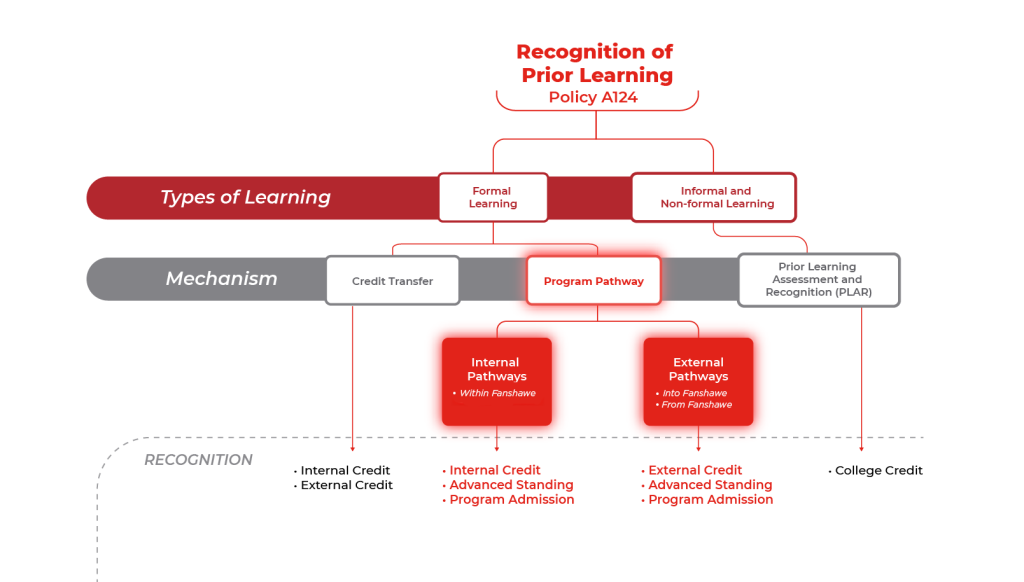Introduction

Program pathways from one post-secondary program or institution to another specify eligibility requirements and how transfer credits will be accepted and applied. Program pathways fall under the umbrella of Recognition of Prior Learning (RPL), which refers to the “processes that allow individuals to identify, document, have assessed, and gain recognition for prior formal, informal and/or non-formal learning at the post-secondary level” (Policy A124).
As noted in Policy A124 and the graphic below, different types of prior learning can be recognized and applied toward an academic credential:
- Formal learning – Formal learning is usually gained at post-secondary educational institutions and is addressed through credit recognition (e.g., internal credits, external credits, advanced standing). Program pathways recognize formal learning and can be internal or external.
- Informal and non-formal learning – Informal and non-formal learning is gained outside of post-secondary educational institutions and is addressed through Prior Learning Assessment and Recognition (PLAR). Faculty resources for PLAR can be found on the Centre for Academic Excellence portal on MyFanshawe.

Image Description
Recognition of Prior Learning Policy (A124)
The diagram illustrates the Recognition of Prior Learning (RPL) Policy A124, categorizing different types of learning and mechanisms for recognition.
-
Types of Learning (represented by a red bar):
- Formal Learning
- Informal and Non-formal Learning
-
Mechanisms for Recognition (represented by a gray bar):
- Credit Transfer
- Program Pathway
- Prior Learning Assessment and Recognition (PLAR)
-
Program Pathway (highlighted in red) leads to:
- Internal Pathways (within Fanshawe)
- Internal Credit
- Advanced Standing
- Program Admission
- External Pathways (into and from Fanshawe)
- External Credit
- Advanced Standing
- Program Admission
- Internal Pathways (within Fanshawe)
-
Recognition Outcomes:
- Credit Transfer results in Internal Credit and External Credit.
- Internal Pathways results in Internal Credit, Advanced Standing, and Program Admission.
- External Pathways results in External Credit, Advanced Standing, and Program Admission.
- PLAR results in College Credit.
The flowchart visually organizes these elements using colour coding (red for key pathways and gray for mechanisms), with arrows indicating movement from learning types through mechanisms to recognition outcomes.
How to Use This Handbook
Academic Schools can use this handbook to develop, implement and maintain internal and external program pathways. Internal pathways move students from one Fanshawe program to another, and external pathways move students from one post-secondary program to a related program at another institution. For employees new to RPL, a glossary of common RPL terms is included in Appendix A, and a list of additional resources is included in Appendix B.
This handbook does not address individual credit assessment for external and internal credit transfer or international student exchange.
Institutional Alignment
The processes used to develop, implement, and maintain internal and external program pathways are aligned with Fanshawe’s mission, values, and the following Academic Policies:
- Policy A124: Recognition of Prior Learning
- Policy A108: Admission of Students to Post-Secondary Programs
- Policy A112: Course Grade System
- Policy A122: Graduation from Approved College Programs
- Policy A126: Program Excellence
The processes outlined in this handbook also align with the policies of the Ministry of Colleges and Universities (MCU) and the Ontario Council on Articulation and Transfer (ONCAT).


